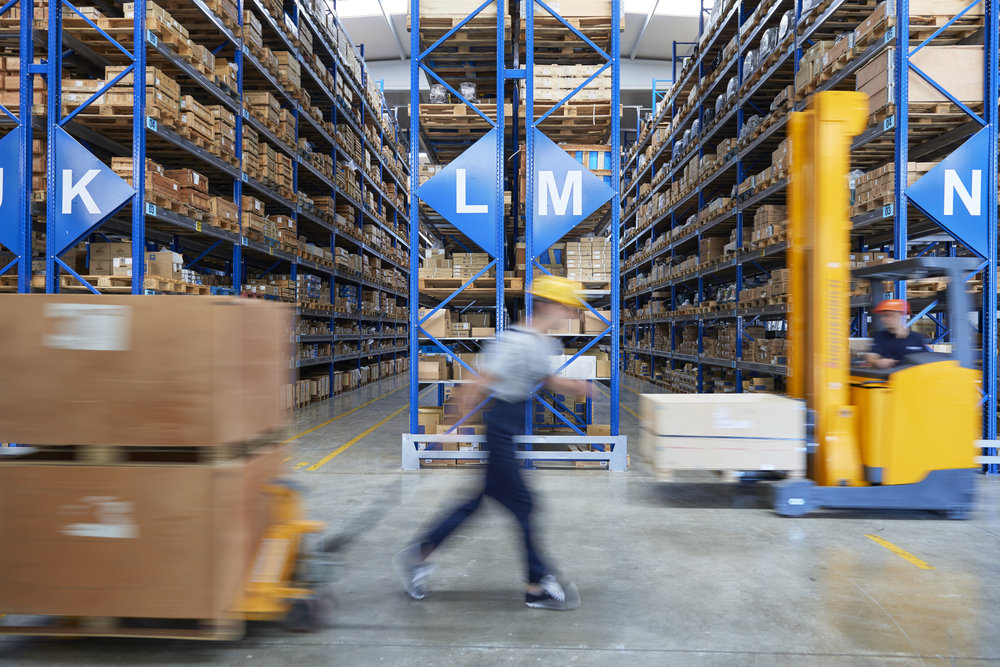Wasp Barcode Technologies: The Barcode Solution People
5 Challenges For Supply Chain and E-Commerce Growth

Thanks to the World Wide Web, the way we shop, pay and how long we’re willing to wait for delivery have changed in every imaginable way. Blame it on Amazon and it's ability to get customers every conceivable product possible within two days, or sometimes, even in the same day. As a result of the rise of e-commerce, unprecedented demands are now placed on asset management systems. Companies that refuse to adapt end up with weak links in their supply chain and find themselves unable to meet the challenges of e-commerce growth.

So, as warehouses continue to grow and become more complex, what should businesses be thinking about as they enter 2017? Consider starting with these five factors—or risk being cut from global competition:
Automation, automation, automation
This isn’t the first time you’ve heard about automation, so why do we keep talking about it? Because a proper
automated inventory tracking software will balance your inventory ratio, costs of goods sold divided by average inventory, in real-time. Think about how big and complex distribution centers are today. Think about how fast consumers want their purchases. Now think about how much money you’re losing if your business’ ratio is too low, meaning you’re spending too much on inventory and not selling fast enough, or if ratio is too high, meaning you have insufficient inventory. Having an automated system makes it easier to switch and ramp up or slow down and strategize, when needed.
[su_divider top="no" size="2"]
[su_divider top="no" size="2"]
An important part of automation is the usage of
barcode scanners which can significantly streamline processes, turn sluggish sales around and achieve productivity and profitability. In fact, a VDC Report found that the “the average annual growth in the 2D imaging sector is likely to be in the region of 17 to 22 percent.” Using an effective barcode scanning system in your warehouse can expedite processing and correspond accurate data in real-time—everything from price, available inventory and sometimes even photos or instructions—so you now know everything that’s moving in your warehouse for an error-free process.
Mobility is the new normal
According to eMarketer, there was an estimated 1.75 billion smartphone users in 2015, which is about 25 percent of the total population. By 2017, that number is expected to reach closer to 40 percent of the total population. When we think about the impact of smartphones, then it’s easy to ask: why wouldn’t mobile play a role in supply chain management? That’s what Wal-Mart asked itself when losing
$3 billion in 2013 after years of inadequate supply chains leading to excess goods surging past sales. Something needed to change, so earlier this year, the retail giant launched
My Productivity app, which allows managers to access real-time data from their smartphones. This means that without leaving the sales floor, managers are able to restock items and access sales.
[Tweet "There was an estimated 1.75 billion smartphone users in 2015."]
If businesses are going to understand customers, they need to get the way they think and behave. Today’s consumers are browsing and making purchases anytime, anywhere, and they’re increasingly doing it on mobile devices every year. So why wouldn’t business also be conducted this way? (
Read this article for more on barcode scanners for iPhone and Android)

Continuity of customer experience
The future of commerce is all about creating a connected customer experience. From laptops to tablets to smartphones, customers want the same seamless, personalized experience—without interruptions—when they go from one device to another. For instance, if you start watching a Netflix movie on your laptop, but later want to finish the movie on your tablet, you’d want to be able to pick up right where you left off.
Supply chains should also be built and managed with continuity in mind. Whether a customer is shopping on their laptop or mobile device, their customer experience with your business should remain the same. This means wherever they are in the world, whatever business location they’re shopping from, it shouldn’t be a problem. This is a harder than it sounds for larger businesses with multiple warehouses across the country or globe. If you have separate inventories, you need a proper asset management system to coordinate experience and communication.
Robotics are coming for your goods
According to market research and consulting firm
IDC, 40 percent of manufacturers will be investing in robotics and autonomous guided vehicles (AGVs) in their warehouses by 2018. That’s a big percentage, and it makes a lot of sense. Think of how much success Amazon has experienced since their $775 million purchase of Kiva robots in 2012. Amazon started using these advanced robots, now simply called Amazon robots,
in July 2014 and as of January 2016, the retail giant reportedly had
30,000 robots in its warehouses. At 16-inches tall, these robots zoom swiftly through large, complex warehouses without bumping into one another, pick up shelves a few inches from the floor and bring the goods to employees.
But like the innovative company Amazon is, it’s not done with robots just because it has them working in its warehouses. For years, Amazon has brought up the idea of using drones to deliver products to consumers. This may sound like an idea
years away from reality, but the truth is, flying drones are
closer than we think. And when it comes to inventory management, drones will do a lot for supply chains. For instance,
DroneScan is a company that connects yesterday’s barcode scanning technology with new drone technology. With DroneScone’s technology, drones can fly freely around warehouses scanning
barcodes applied to shelves and products in order to update inventory systems and send alerts when goods are running low or have remained on shelves past its lifespan.
Proper warehouse layout for improving supply chain
If we have all this technology, then why do we need to think about something that sounds as archaic as warehouse layout? Because systems matter, and the more complex and competitive the world gets, the more companies need to utilize warehouse spaces as effectively as possible. For instance,
think about IKEA’s rows of meticulously stacked boxes. Putting items in specific rows and columns was not an accident. That was a strategic supply chain decision that resulted in a kind of efficiency that’s never been seen before IKEA came along. The company separates its products into high-flow and low-flow facilities to drive down costs-per-touch, an asset management tactic that says the more hands that touch a product, the higher that product’s costs. The result? IKEA was given a brand value of $11.8 billion in 2015 by
Forbes’ list of the world’s most valuable brands (Read more about IKEA’s inventory system here).
Here’s what else
IDC predicts for manufacturing supply chains in the near future:
- By the end of 2016, the majority of all manufacturers will be actively employing commerce networks in their supply chains to facilitate either demand, supply, or the development of new products.
- By the end of 2018, 25% of manufacturers will have implemented a micro-logistics strategy within part or all of their business to support a more distributed inventory management strategy.
- By 2018, 75% of manufacturers will coordinate enterprise-wide planning activities under the umbrella of rapid integrated business planning.
- By 2019, 50% of manufacturers will have modernized their logistics network to leverage 3D printing, robotics, and cognitive computing to support innovative postponement strategies.
- By the end of 2019, enterprise-wide improvements in resiliency and visibility will have rendered short-term forecasting moot for 50% of all consumer products manufacturers and 25% of all others.
- By the end of 2016, one-third of all manufacturers will be actively integrating their “traditional” supply chain processes with product and network design, manufacturing, and service.
- By the end of 2017, the need for visibility, scalability, and flexibility across the value chain will drive 60% of manufacturers to invest in cloud-based WMS and TMS solutions aligned to their trade partner networks.
- By 2018, 40% of manufacturers will be investing in robotics, autonomous guided vehicles (AGVs) and associated systems within their warehousing operations to drive automation into their fulfillment processes.
- By 2018, proliferation of advanced, purpose-built, analytic applications aligned to the Internet of Things (IoT) will result in 15% productivity improvements for manufacturing supply chains.
- By 2020, 50% of the operational jobs in the supply chain will have evolved into “knowledge” roles required to support new technologies like cognitive computing and modern robotics.
How do you see robotics to influence your company in the short term? How are robots already working in your field?





